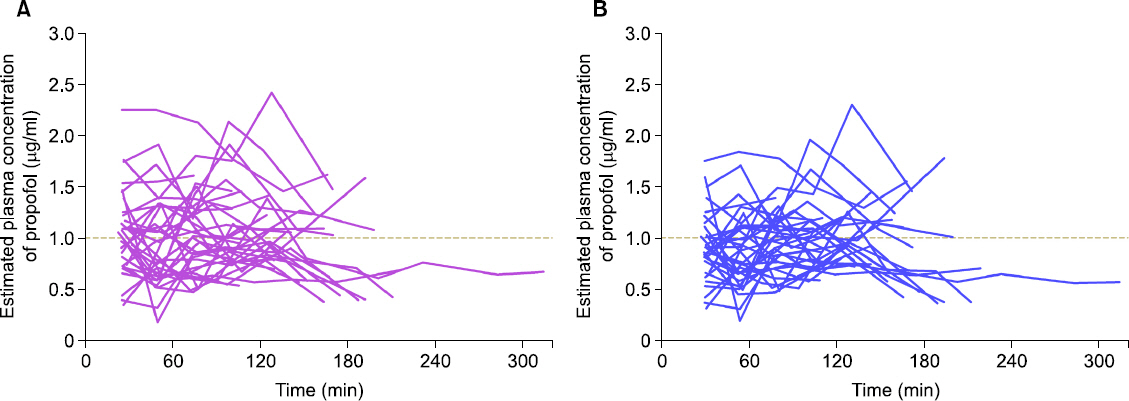1. van den Nieuwenhuyzen MC, Engbers FH, Vuyk J, Burm AG. Target-controlled infusion systems:role in anaesthesia and analgesia. Clin Pharmacokinet 2000; 38: 181-90. PMID:
10.2165/00003088-200038020-00003. PMID:
10709777.


2. Absalom AR, Glen JI, Zwart GJ, Schnider TW, Struys MM. Target-controlled infusion:a mature technology. Anesth Analg 2016; 122: 70-8. PMID:
10.1213/ANE.0000000000001009. PMID:
26516798.


3. Marsh B, White M, Morton N, Kenny GN. Pharmacokinetic model driven infusion of propofol in children. Br J Anaesth 1991; 67: 41-8. PMID:
10.1093/bja/67.1.41. PMID:
1859758.



4. Struys MM, De Smet T, Depoorter B, Versichelen LF, Mortier EP, Dumortier FJ, et al. Comparison of plasma compartment versus two methods for effect compartment--controlled target-controlled infusion for propofol. Anesthesiology 2000; 92: 399-406. PMID:
10.1097/00000542-200002000-00021. PMID:
10691226.


5. Schnider TW, Minto CF, Gambus PL, Andresen C, Goodale DB, Shafer SL, et al. The influence of method of administration and covariates on the pharmacokinetics of propofol in adult volunteers. Anesthesiology 1998; 88: 1170-82. PMID:
10.1097/00000542-199805000-00006. PMID:
9605675.


7. Lee EH, Lee SH, Park DY, Ki KH, Lee EK, Lee DH, et al. Physicochemical properties, pharmacokinetics, and pharmacodynamics of a reformulated microemulsion propofol in rats. Anesthesiology 2008; 109: 436-47. PMID:
10.1097/ALN.0b013e318182a486. PMID:
18719441.


8. Allford MA, Mensah JA. Discomfort on injection:a comparison between two formulations of propofol. Eur J Anaesthesiol 2006; 23: 971-4. PMID:
10.1017/S0265021506001049. PMID:
16824242.


9. Kim KM, Choi BM, Park SW, Lee SH, Christensen LV, Zhou J, et al. Pharmacokinetics and pharmacodynamics of propofol microemulsion and lipid emulsion after an intravenous bolus and variable rate infusion. Anesthesiology 2007; 106: 924-34. PMID:
10.1097/01.anes.0000265151.78943.af. PMID:
17457123.


10. Cox EH, Knibbe CA, Koster VS, Langemeijer MW, Tukker EE, Lange R, et al. Influence of different fat emulsion-based intravenous formulations on the pharmacokinetics and pharmacodynamics of propofol. Pharm Res 1998; 15: 442-8. PMID:
10.1023/A:1011980432646. PMID:
9563075.


11. Ward DS, Norton JR, GuivarcŌĆÖh PH, Litman RS, Bailey PL. Pharmacodynamics and pharmacokinetics of propofol in a medium-chain triglyceride emulsion. Anesthesiology 2002; 97: 1401-8. PMID:
10.1097/00000542-200212000-00011. PMID:
12459665.


12. Glen JB, Servin F. Evaluation of the predictive performance of four pharmacokinetic models for propofol. Br J Anaesth 2009; 102: 626-32. PMID:
10.1093/bja/aep043. PMID:
19297371.



13. Beal SL, Sheiner LB, Boeckmann A, Bauer RJ. NONMEM users guides. NONMEM Project Group, University of California. San Francisco. 1992.
14. Glen JB, White M. A comparison of the predictive performance of three pharmacokinetic models for propofol using measured values obtained during target-controlled infusion. Anaesthesia 2014; 69: 550-7. PMID:
10.1111/anae.12631. PMID:
24720380.


15. Varvel JR, Donoho DL, Shafer SL. Measuring the predictive performance of computer-controlled infusion pumps. J Pharmacokinet Biopharm 1992; 20: 63-94. PMID:
10.1007/BF01143186. PMID:
1588504.



16. Rau J, Roizen MF, Doenicke AW, OŌĆÖConnor MF, Strohschneider U. Propofol in an emulsion of long- and medium-chain triglycerides:the effect on pain. Anesth Analg 2001; 93: 382-4. PMID:
10.1097/00000539-200108000-00029. PMID:
11473865.


18. Wicklmayr M, Rett K, Dietze G, Mehnert H. Comparison of metabolic clearance rates of MCT/LCT and LCT emulsions in diabetics. JPEN J Parenter Enteral Nutr 1988; 12: 68-71. PMID:
10.1177/014860718801200168. PMID:
3125359.


19. Choi BM, Lee HG, Byon HJ, Lee SH, Lee EK, Kim HS, et al. Population pharmacokinetic and pharmacodynamic model of propofol externally validated in children. J Pharmacokinet Pharmacodyn 2015; 42: 163-77. PMID:
10.1007/s10928-015-9408-2. PMID:
25724290.



20. Choi BM, Lee HG, Byon HJ, Lee SH, Lee EK, Kim HS, et al. Algorithms to rapidly achieve and maintain stable drug concentrations at the site of drug effect with a computer-controlled infusion pump. J Pharmacokinet Biopharm 1992; 20: 147-69. PMID:
10.1007/BF01070999.



21. Absalom AR, Lee M, Menon DK, Sharar SR, De Smet T, Halliday J, et al. Predictive performance of the Domino, Hijazi, and Clements models during low-dose target-controlled ketamine infusions in healthy volunteers. Br J Anaesth 2007; 98: 615-23. PMID:
10.1093/bja/aem063. PMID:
17389691. PMID:
PMC3838936.













